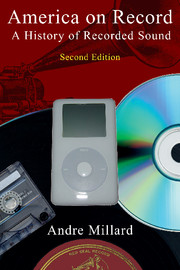Book contents
- Frontmatter
- Dedication
- Contents
- Preface to the second edition
- Preface to the first edition
- Introduction
- Part One The acoustic era
- Part Two The electrical era
- Part Three The digital era
- 16 The media conglomerates
- 17 Into the digital era
- 18 Consolidation and connectivity in the digital era
- Abbreviations used in the notes
- Notes
- Select discography
- Select bibliography
- Subject index
- Recordings index
- Motion picture index
17 - Into the digital era
from Part Three - The digital era
Published online by Cambridge University Press: 05 February 2015
- Frontmatter
- Dedication
- Contents
- Preface to the second edition
- Preface to the first edition
- Introduction
- Part One The acoustic era
- Part Two The electrical era
- Part Three The digital era
- 16 The media conglomerates
- 17 Into the digital era
- 18 Consolidation and connectivity in the digital era
- Abbreviations used in the notes
- Notes
- Select discography
- Select bibliography
- Subject index
- Recordings index
- Motion picture index
Summary
In 1977, when the audio industry was celebrating the 100th anniversary of Edison's invention of the phonograph, a research project in Japan had already established the technology of the next hundred years of recorded sound. While the mature technology of analogue recording was being honored, an entirely new system of saving sound had been successfully developed in the laboratory. Digital recording brought improvements in reproduction which surpassed the advances of electric over acoustic technology. Digital recording brought about a whole new era in the history of recorded sound.
Digital transformation of sound was first attempted in the laboratories of the telephone companies in their never-ending quest to get more messages on their wires. Like the acoustic and electrical eras that preceded it, the digital era of sound recording was an application of technology devised to send telephone messages of electric speech. Turning the sounds of speech into numbers meant that more words could be crammed into a single cable and that the problem of crosstalk between messages was minimized. The binary codes of digital speech could also be easily transmitted.
The first method of electrical communication was in fact digital: Samuel Morse's method of opening and closing electrical circuits sent numbers (dots or dashes) rather than measurable physical quantities. It was Bell's invention of the telephone that established analogue communication and saving of sound; his device turned the varying pressure of sound waves on a diaphragm into currents of electricity which varied in direct relationship to the changes in pressure.
Analogue technology served the communications and recorded-sound industry well, but in the 1930s researchers in telephone laboratories began to examine digital methods of transmitting sound. Their experiments were based on pulse-coded modulation (PCM) of a continuous signal. This technique was based on the concept that a continuous signal could be reconstructed from isolated samples and that these samples could be approximated by discreet numbers. PCM was first outlined in a patent obtained by P. M. Rainey of Western Electric in 1926 and elaborated by A. H. Jeeves, another telephone engineer, in 1937.
- Type
- Chapter
- Information
- America on RecordA History of Recorded Sound, pp. 346 - 366Publisher: Cambridge University PressPrint publication year: 2005



